
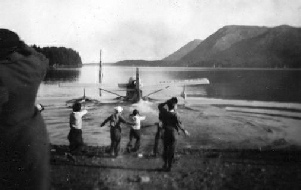
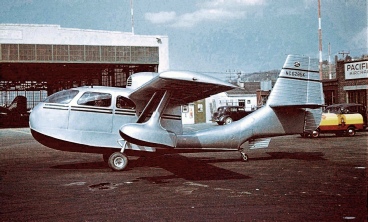
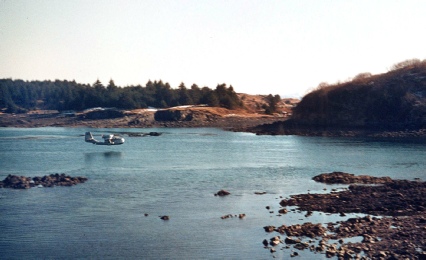
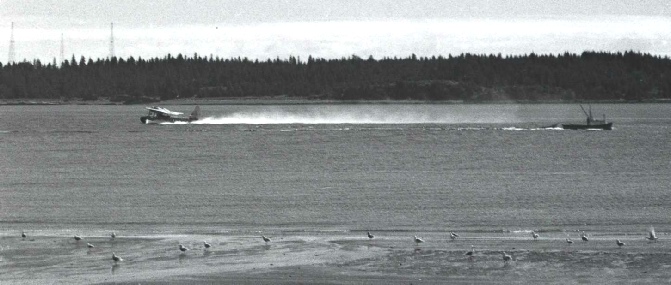
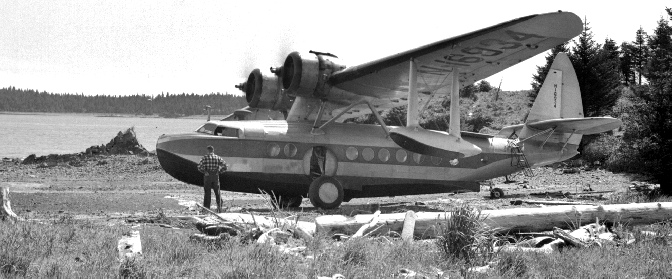

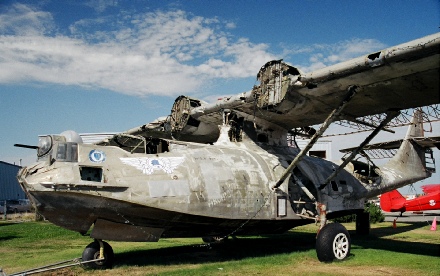
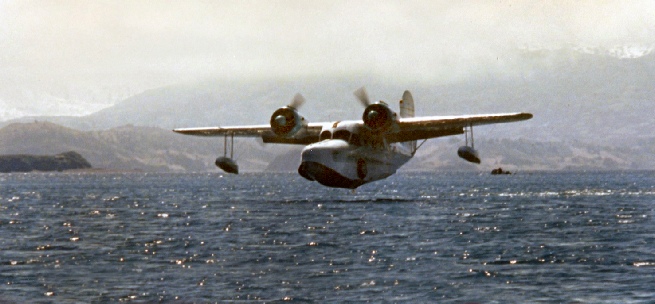
Left: Grumman Widgeon N56198 waits at the ramp by the Kodiak Channel in the mid-
The plane on the left crashed in the Crown Mountain Pass on a flight from Afognak to Old Harbor in April of 1961. The pilot apparently blacked out due to a carbon monoxide leak in the cabin, and came to out on a snow bank high on the mountain. He was later spotted by other Kodiak Airways pilots, and a Coast Guard helicopter rescued him. (It is impossible to tell the story of these wonderful planes without also recounting the dangers of flying in the challenging airspace around Kodiak Island.)
Introduction
After World War II, airplane manufacturers thought amphibians and even flying boats were the wave of the future. Howard Hughes tested his magnificent “Spruce Goose” and companies such as Republic and Grumman made amphibious aircraft in an attempt to tap into the private and commercial market. In most places, the idea never caught on, but around Kodiak Island, the amphibian became the most common commercial aircraft, and remained so for the better part of three decades. This article features some very rare photos of those amphibians, and includes a tribute to the Grumman Goose’s “pretty little sister” (my designation), the Widgeon. For this article I am indebted to the shared memories of Bob Hall, founder of Kodiak Airways, Steve Harvey, avid Widgeon pilot and aviation archivist, Fred Ball, who travels the world teaching pilots how to fly those old Grummans, and Bob Leonard, a pilot who flew amphibians around Kodiak Island for many years. They wrote me after reading the original “Goose Stories” article, and I am honored to share what they shared with me.
The Republic SeaBee with Memories from Bob Hall
Left: Bob Hall in a new SeaBee in Seattle, preparing to head to Kodiak in 1947. Right: A Kodiak Airways SeaBee preparing to take off in this 1953 photo
The SeaBee was a unique amphibian, designed to be popular with the private pilot
market. It had a “pusher” engine, with the prop facing the tail. It looked a little
bit like a small PB-
Kodiak Airways bought some used SeaBees and put them into regular service in the early 1950’s, and as Bob Hall says, “we flew their wings off!” They used SeaBees in their commercial operation until they sold the last one in 1959 (they got their first Grumman Widgeon in 1950 and their first Goose in 1956). I saw only a few when I was a kid, and never got to fly in one. But in the postwar 1940’s, many were used in Alaska. The Grummans proved to be better suited to the Alaskan bush, especially where heavy loads, speed or marginal weather conditions were concerned, but the SeaBee holds an important place in Kodiak’s aviation history as the first planes used commercially around the islands by Bob Hall and Kodiak Airways.
Above Left: A SeaBee prepares to land in the Kodiak channel in this rare photo from the 1950’s. Above Right: A group of village kids play in the prop wash of a SeaBee as it leaves the beach in Ouzinkie, in this summer photo from the early 1950’s. If you look closely, the photo even shows the exhaust smoke. (Miss Rold’s scrapbook, Baker Cottage Baptist Mission, Ouzinkie). Bottom: A view down the Kodiak Channel from the Evangel in the early 1950’s reveals Kodiak Airways’ ramp with two SeaBees parked and ready to go.
With seven outlying villages and twenty-
Above: A Sikorsky amphibian loads up and takes off. They were taken by my Dad, Rev. Norman Smith, in 1951, at the seaplane ramp that used to be at Mission Beach in Kodiak.
The above photos presented quite a mystery at first. My resources for research were
limited and I could not determine which model it was, so I sent the photo to Bob
Leonard, former Kodiak Airways pilot, who sent me the following information: this
is an Alaska Airlines Sikorsky S-
There were apparently only a few dozen of this model that made it out of the war and into commercial service, and this might be the only one that saw service in the Kodiak area. Steve Harvey adds that this plane was operated by Alaska Airlines out of Anchorage, and was used to ferry cannery workers out to Chignik and Kodiak from there. While landing in Chignik it hit a log, and sank before they could beach it. I heard a rumor that an effort to reconstruct and restore this plane was undertaken, but I have no information as to the progress of that project. But the two photographs above document yet another unusual item in Kodiak’s rich aviation history!
The color photo below comes from the Steve Harvey collection, and shows “NC1693 Yukon
Dotty” at the Mission Beach landing ramp in the sunset, early 1950’s. Another long-
The Consolidated PB-
Above: In this rare photo, a PB-
The PB-
This PB-
More Amphibian Adventures (Grumman Amphibian Aircraft)
By Timothy Smith, Revised in 2011, latest revision in 2020
More Amphibian Adventures
Part of the “How to Get to Kodiak” series of articles
A Sequel to “Goose Stories”
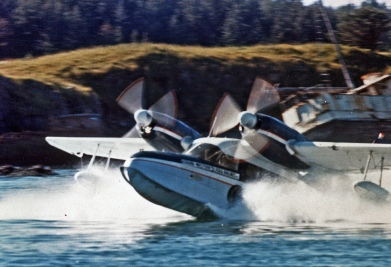
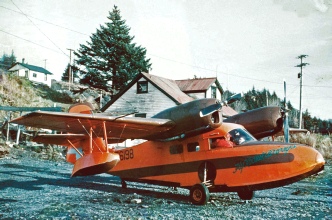
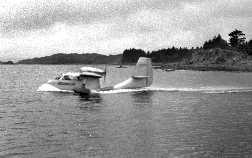
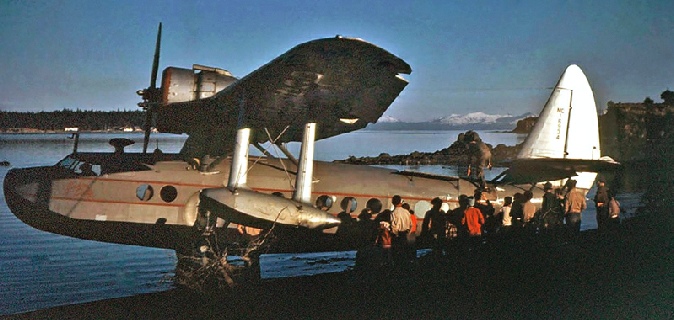
Alaska Airlines Sikorsky Amphibians at Mission Beach

Back to Business: Recovery after the Tidal Wave
Kodiak Airways in the 1964 Tidal Wave
Bob’s experience of the Earthquake and Tidal Wave of March 27, 1964, was dramatic and moving. We associate the tsunami disaster with sunk fishing boats and destroyed villages and canneries. But the waves nearly swept away Kodiak Airways, too. Although none of his pilots were lost in the disaster, Kodiak Airways was nearly destroyed. Bob Hall writes, “Kodiak Airways was left with two flyable planes. The hangar with all tools, spare parts and freight to be delivered was swept away. Our office building and all records were also gone, with the exception of the U. S. Mail, which was in bags that we were able to quickly remove. I threw the mail on our truck along with the cash box and drove up the hill as the water covered the back wheels. The reward for this effort was a plaque from the Post Office Department. Our home was on high ground, and all the Airways employees and families gathered there. The city power was out, and so we brought out the Coleman gas stoves and kept food before everyone. We watched the water surge in and out in the light of a full moon. All our losses except the planes were not covered by insurance.”
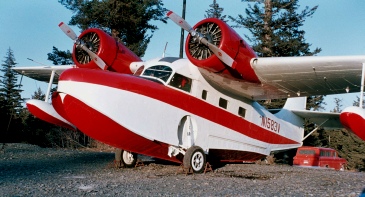
The day following the Tidal Wave, the workers of Kodiak Airways had a meeting. Every one of Bob Hall’s team decided to keep going, and to find a way to get back in business. It was a tribute to the hardy spirit of Alaskans, but also to Bob’s leadership. The Kodiak Airways model of personal integrity, creative problem solving, and hard work was the very opposite of governmental bureaucracy, as they would soon find out. Their rebuilding efforts hit a major snag a few months later when Bob and his lawyer went to Washington D.C. to try to finalize the loans that would be necessary to rebuild. Bob remarks, “Washington runs on paperwork. We were repeatedly asked for records, and we repeatedly reminded them that the records are gone! The only records were the quarterly and annual reports we had previously sent to Washington. It finally penetrated,” Bob reported, and he returned from D.C. with enough funds to start the recovery operation.

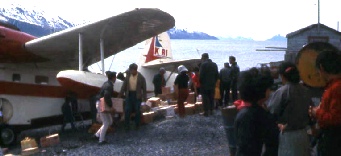
Top: Back to business, back to Old Harbor! As this photo of two Gooses on the new airstrip of the rebuilt village of Old Harbor demonstrates, Kodiak Airways bounced back from the Tidal Wave, and within a year or two, business was booming again.
N87U, which features in so many of the photos on this web site, was actually purchased the summer after the Tidal Wave, to replace a Goose that had been swept away in the hangar in Kodiak channel when the tsunami hit. (From a computer print)
Middle: A Goose takes off in the bay beside Old Harbor in the winter of 1966.
Bottom: A Goose pilot often had to deal with lots of freight and mail, as evidenced by this photo from Old Harbor in 1966.
When the weather cleared up after days or weeks of delay, the pilots would have their hands full trying to catch up on mail, passenger and freight traffic that had stacked up at all the stops, a problem that still plagues fliers in the Kodiak Island area.

Left: Kodiak Airways after the Tidal Wave: an envelope full of these old Kodiak Airways flight schedules was found in my Dad’s office after he passed away.
This flight schedule shows a flight between Port Wakefield and Larsen Bay in October of 1964, a time when Dad was beginning to visit the villages by air after the Mission Board’s decision to sell the Evangel. The ticket is signed B. L., which possibly indicates Bob Leonard was the pilot. It still lists several sites that by that time had been wiped out by the Tidal Wave of March of that year.
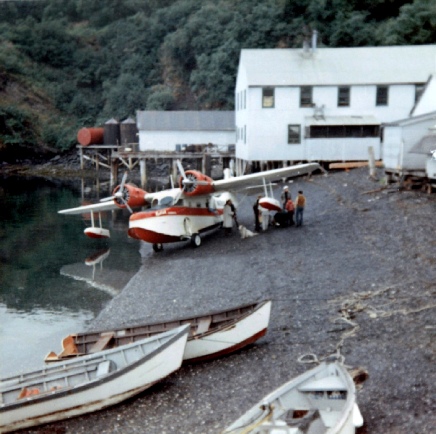
Right: In contact with the outside world: A Kodiak Airways Goose brings mail, supplies and passengers to Parks Cannery in Uyak Bay in 1968, in this iconic photo sent by a man who worked there at that time.
By the mid-
Then in the early 70’s, the oil boom at Prudhoe Bay sapped the company of good mechanics
and pilots, who went elsewhere for better pay than Kodiak Airways could provide.
In the mid 1970’s, an ill-
But the purpose of this article is not to simply retrace the history of Kodiak Airways. Thanks to a former Kodiak Airways pilot, I am pleased to present the following tale:
Bob Leonard’s Larsen Bay Widgeon Experience:
Bob Leonard was a Kodiak Airways pilot, flying everything from the Piper Super Cub float plane to the Grumman Goose. Kodiak Airways used Larsen Bay as a fueling station for the South End. For several seasons in the 1960’s, Bob Leonard worked for Kodiak Airways out of Larsen Bay with a Grumman Widgeon, using it as a way of keeping the Alaska Packers’ Association’s fleet of salmon seiners supplied and as a way of getting an advantage over other canneries. Each cannery had a fleet of seiners, usually sporting the cannery’s unique paint scheme, plus a fleet of larger tenders, which would load up the fish from several seiners and rush them to the cannery for processing.
Whichever cannery’s seiners got to the fish first, and then got their tenders to
the seiners first, would have the most fish to process, and hence the greatest profit.
Likewise, scheduling the tenders to arrive at staggered intervals helped keep the
cannery well-
“As the fleet boss Joe is responsible for finding out and keeping a total of the
amount of fish his fleet is catching each day. His second job, based on the amount
of fish his fleet is catching, is to schedule the cannery tenders to the various
bays to collect the fish from the small seine boats. This is a real balancing act,
because he needs to have one or more full tenders arriving at the cannery each day
in order to keep the cannery processing fish on a day-
“We spot only three of our seiners along with five or six other boats from our competitors. I position myself so to be able to fly past our three boats while Joe checks where the waterline is. We fly past alongside, keeping about fifty feet above the bay, and, passing each boat, Joe makes a notation on his clipboard. Remember, Joe knows these boats and, believe me when I say it, he can estimate to within 50 fish or so how many fish are lying inside each boat’s hold, all while flying past them!”
The natural question is: why not use the radio instead? Bob’s answer is simple: “Let’s not forget the competition. Those other canneries around the island, who are just as intent on catching more than their share of the fish run, are all listening in for any sign of a heavy fish run starting in one of the bays. If Joe had his boats giving him fish catch totals, via the radio, and they were doing well in a particular bay, the boats of the competition would be coming full speed towards that bay as fast as they could get there.” Thus the flyby method preserves the secrecy and insures that the orange and black team will get their fair share of the catch!
Bob’s story resumes after these photos of a famous and well-
The coffin door Widgeon called the “Easter Egg”
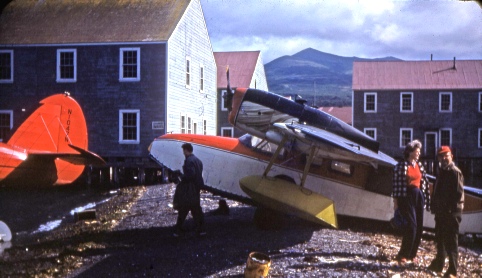
Above Left: The Kodiak Airways Widgeon featured in the photo of Bob Hall and the
sacks of mail here unloads passengers at the narrow spit of beach Bob Leonard used
in the story. This photo is from the mid-
Above Right: Gil Jarvella, Kodiak Airways pilot, helps an unidentified passenger (possibly Dorothy Bucklin, a Baptist official) into a Widgeon in this 1956 photo taken from the same location as the previous one. The author’s parents, Rev. Norman and Joyce Smith stand beyond the plane, and the author (a young Timmy Smith) watches, fascinated, from the foreground. This Widgeon features a “coffin” door in the roof as opposed to the side hatch featured on Gooses and most Widgeons.
Above Right: A Larsen Bay beach shot, this time from the top of the beach looking outward, shows the “Easter Egg” loading passengers.
The photo is from a highly faded half-
Below: Here’s a fairly accurate color shot of the “Easter Egg” Widgeon, also taken
in Larsen Bay in the mid-
It is nearly sunset, which affects the color – notice the buildings, which should
be gray. It’s low tide, and the plane is below the visible high tide line. You can
guess why such a wild-
Now Back To Bob Leonard’s Story
Bob would fly Joe back to the cannery after the early morning run, take a quick nap, and hop back in the Widgeon for another check of the seiners, and to ferry supplies and spare parts to any of the seiners in any of the bays. As an amphibian, the Widgeon simply would touch down near the seiner, get met by the skiff, unload, and take off again. Bob’s typical day would last until after 10:00 PM, and then up again in a few hours to be in the air by 3:30 AM. But this system made life much easier for Joe, the fleet boss, and resulted in a much more efficient (and hence more profitable) season for the Larsen Bay cannery. Bob sums up his cannery and Widgeon experience:
“Sometimes I would take a mechanic and drop him off at a boat to work. If a crewman got sick I would pick him up so he could get treatment at the cannery health clinic. A few times I picked up crewmembers that had been injured on the job and took them direct to the hospital in Kodiak. There was never a dull day! This second afternoon flight covered the same bays as our morning flight but took much longer because of landing in each bay and dropping off supplies.
“Usually I was back to the cannery by 10 PM. After servicing my plane I could catch another block of sleep, maybe three hours or more. Then, awake again. Cold water splashes my face. It was a new day. Soon my Super Widgeon and I would be again flying the fleet boss, Joe. This was my daily schedule during the hectic salmon season, and this was my part in getting those little salmon cans onto your grocery shelves!”
Bob Leonard’s unique narrative is from his story, “That Little Can of Salmon,” and is used with his kind permission.
Kodiak Western’s “Peter Rabbit” Goose flies over Kodiak waters in this late ’70’s photo.
The end of the line for Kodiak Airways, then called Kodiak Western Alaska Airways, and the strange adventures that the Grumman Amphibians seem to have, can be pretty neatly summed up in the story of the “Peter Rabbit” Goose. The plane was purchased in 1976, and got its name because of its tail number, N72PR. Since the shorthand was often to refer to a plane by the last two digits or letters of its tail number, PR soon morphed into “Peter Rabbit”.
By the late 1970’s when the plane joined the fleet, Kodiak Airways was no more, merged with Western Alaska Airways, and on its way to slow extinction. This Goose was usually flown by Fred Ball when my brother Kelly worked for Kodiak Western. With someone else piloting it, the plane ran off the runway in Old Harbor in 1978 and got pretty beat up. Fred Ball flew in, pounded it back together and coaxed it back to Kodiak (a testament to both plane and pilot)! The plane was sold when the company went under.
What the NTSB called a “hard water landing” near Long Island, off Kodiak, caused pontoon damage in October of 1985 while the Goose was owned by Westflight Aviation out of Ketchikan. It was later sold to an outfit in Palau, Micronesia, and another small chapter in Alaska aviation drew to a close. This plane was then featured in the television version of South Pacific in 2002 (painted in Navy colors), and is currently being restored, according to Internet sources. So it’s still having grand amphibious adventures, and still flying!
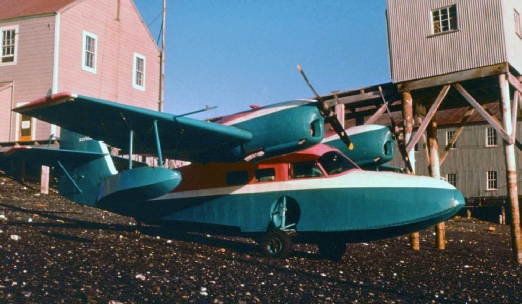
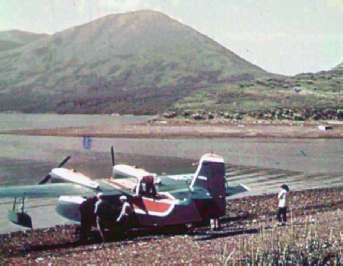
Only 25 coffin-
Above: The old “Peter Rabbit” Goose comes in for a landing piloted by Fred Ball in this photo taken by a fellow Kodiak Western pilot in the late 1970’s. I simply cannot hide my admiration for those old Grumman amphibians!
For more on Kodiak aviation, including much more information on the Goose and Widgeon, and many more historic photos, please follow the links in the photos below.


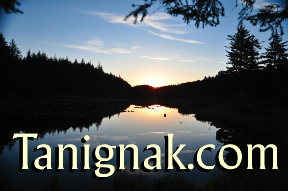

To Find Out More About Tanignak.com, Click HERE
To Visit My “About Me” Page, Click HERE
To Return to Tanignak “Home,” Click the Logo Below:
Information from this site can be used for non-


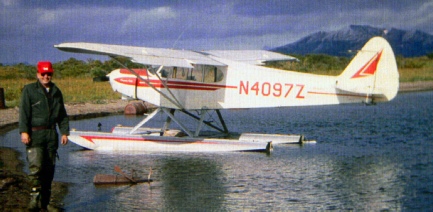
Left: I shot this interesting photo in 2004 of a World War II PB-
Kodiak Airways’ first Goose, N1583V, in its temporary quarters at Harvey Flying Service (which was located at the KDK “municipal airport” landing strip) shortly after the Tidal Wave in 1964. Generosity among competitors — there was a lot of that sort of thing after the Tidal Wave, as the town and the islands struggled to recover.
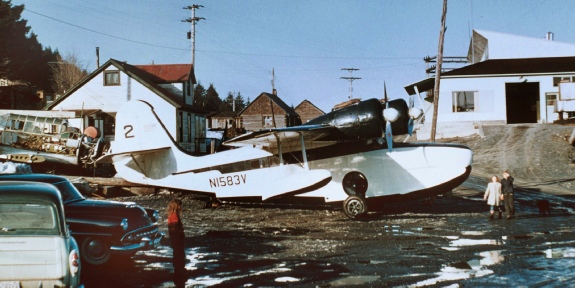
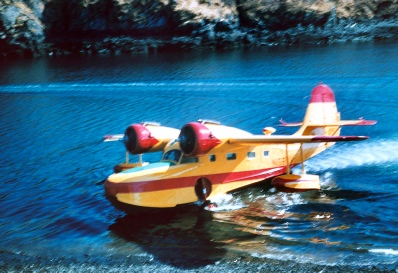
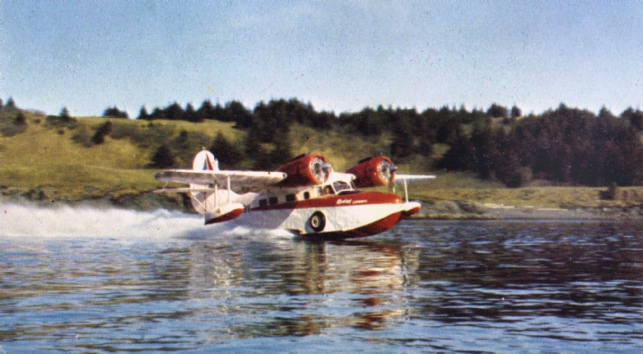
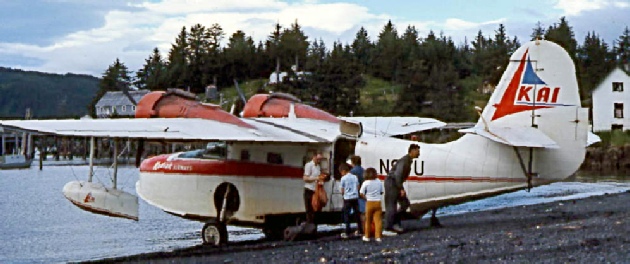
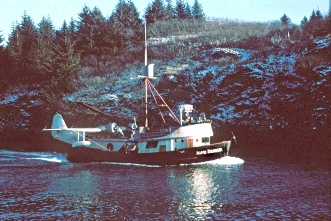
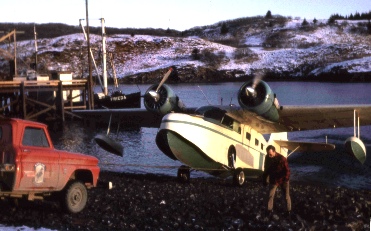
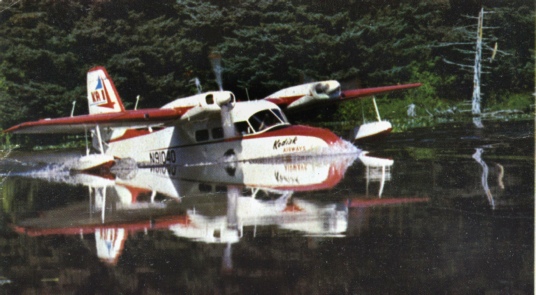



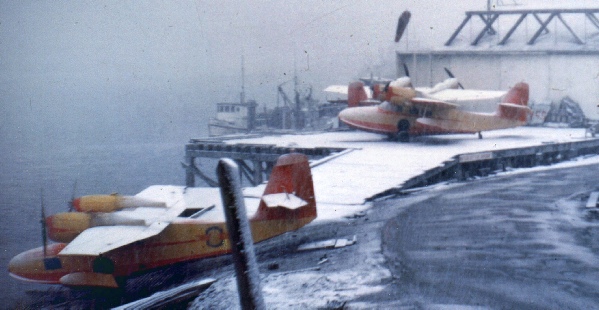
A Goose Gallery from the 1950’s and 60’s
Goose Number N1583V
In the rare photo below, N1583V is waiting on the beach in the Kodiak channel, still painted in its Catalina Airlines colors.
Goose N1583V had a long history. It began its service in Iceland during the War years, then it was brought to the United States where it flew for years with Catalina Airlines in California, providing service to and from Avalon. Then it was brought to Alaska in 1956 to be part of the Kodiak Airways fleet as the first Goose they had. It was lost with five fatalities (including the pilot, my friend Robbie Hall) on a flight from Old Harbor to Kodiak in December of 1974.
Above: This Grumman Goose (also most likely N1583V, in its third paint scheme with Kodiak Airways) takes off in Kodiak channel in this publicity shot from a Kodiak Airways postcard in the 1960’s. “A Shower of Spray and We’re Away!” was the company motto. As my article “Goose Stories” at this web site demonstrates however, a lot of that spray can wind up on your lap when it’s time for a water landing!
One of Kodiak Airways’ most photographed Gooses (nobody calls them “geese”) is the venerable N87U. The first article, “Goose Stories,” has several photos of it in action, and a photo of a display from the Smithsonian with N87U in Kodiak Airways colors. This is the second photo of a sequence taken in Ouzinkie in 1969 by Travis North. My Dad, Rev. Norman Smith, is heading up the beach and obscures the N87U. Note the orange bag in the other man’s hand: that’s the incoming mail. The man is Hender Toms, former executive with Ouzinkie Packing Corp., and in 1969 worked for Kadiak Fisheries and ran the Ouzinkie post office and store. Kids gather on the beach to watch the action.
N87U in Trouble: A Photo Sequence
Above photos: N87U had a bit of trouble in February of 1966 when it lost an engine. Here the Madre Dolorosa hauls it in to town (Dirk Sundbaum photo). They hoisted it off the stern and brought it up the ramp (second and third photo). Incidentally, the fishing boat later went down under tragic circumstances, but N87U is still flying as of May 2005 when this article was originally posted. From photos at various flight shows, the Goose has been restored to its original Navy paint scheme. The incident in the photos above was a close call, a lucky break. Conditions in the remote corners of Kodiak Island, with aging equipment and unpredictable weather, sometimes make it one of the most challenging places for aviation in the world.
For more on the Grumman Goose and the experience of flying in one, please check out my articles, “Goose Stories”, “From Shore to Sky”, “Runways to Remember”, “Goose and Widgeon: Still Flying!”, and “Ouzinkie Rebuilt”, all posted here at Tanignak.com. Links at the bottom.
The Widgeon, Goose’s Pretty Little Sister
Above: Super Widgeon N91040 is featured in a Kodiak Airways publicity postcard photo. Kodiak Airways began using Widgeons in 1955, and continued to use them until they ceased operations.
I call the Widgeon the Goose’s “pretty little sister” because of its smoother lines,
streamlined engine cowlings (there were several engine configurations) and stylish
rounded windshield, especially when compared with the rather dowdy-
Kodiak Airways bought their first Goose in 1956 according to Bob Hall, and they soon became the flagship aircraft of Kodiak Airways. By the time I began traveling regularly in the late 1960’s (I was in boarding school in Kodiak, and commuted home to Ouzinkie a few times a month), Kodiak Airways had more Gooses than Widgeons in their fleet. But the Widgeon has a longer history in Kodiak’s commercial aviation, and unlike its older and larger sibling, can still be found flying in the Kodiak area. Steve Harvey’s gorgeous Widgeon is still in regular commercial use in Kodiak, and I am sure there are other pilots who find it to be perfect for reaching the remote areas quickly and efficiently. The next two sections of this article feature the venerable Grumman Widgeon, through the memories of two legendary Alaskan “bush pilots,” Bob Hall and Bob Leonard.
Above: The postcard Widgeon unloads passengers in Ouzinkie in this detail of a photo
taken from the window of a departing Goose (circa 1969). I once landed in Ouzinkie
channel (we came in around the point past the dock) in three foot swells in a Widgeon,
when such a landing could have caught a pontoon and flipped her. It was a bone-
Bob Hall Remembers
Most of the details about Kodiak Airways in this section and throughout the article
are from an eight-
Bob Hall flew SeaBees in the early years, but was very impressed with the performance
of the Grumman Widgeon, a plane that was later to become a main part of his operation.
He writes, “Port Williams had an ex-
The next year, Bill brought a different Widgeon and again dazzled us with its speed. However, he took the drain plugs out on the beach to let excess water out, and then put it out on a buoy for the night. The night watchman caught sight of it just as it sank – the plugs had not been put in place!” Then the company got the original Widgeon after it was repaired and brought it back to Port Williams. Bob says, “it was repaired and was painted a shiny yellow with red trim. They offered to sell me the plane and give me all their business in exchange for half my billings until the plane was paid off. It was an offer I could not refuse!” Thus Kodiak Airways acquired their first Widgeon in 1950, and gradually adopted the yellow and red color scheme for their subsequent fleet of Widgeons.
Although there were other sources of revenue, such as Bob’s increasing village passenger and mail services, 1959 was a disastrous year for nearly everyone. A horrible salmon season meant the little air service was not getting enough business. Bob notes, “A couple of floating canneries left the island owing us several thousand dollars each. I was also faced with closing the doors because none of the local people could pay their bills. However, Wakefield Fisheries, which was a herring processor at the time, changed their tactics and pioneered the king crab fisheries. All the locals went to work for them and suddenly, Kodiak Airways was back in the swing of things.” (For more information on Port Wakefield and photos of their early crab operation, please see my article called “Cannery Work” at this website).
A Grumman Widgeon Photo Gallery
Above Right: This rare photo shows a Kodiak Airways Widgeon taxiing into Kitoi Bay
in the mid-
Top Left: In Memoriam — The author stands in front of the Benny Benson memorial in Seward, Alaska, in 1996. Benny grew up in Seward, but spent much of his adult life as an employee of Kodiak Airways, keeping the planes in good running order. Besides his spot in Alaska history as the designer of the flag, he is part of the story of Kodiak aviation, and I’m pleased to honor his memory here.
Below: Kodiak Airways’ fleet of Widgeons awaits a break in the weather in this rare
photo, from the mid-
About the photo below: The mission boat Evangel, run by my parents, Rev. Norman and Joyce Smith, and featured in a series of articles at this site, “Island Journey With the Evangel ,” waits at the dock beyond. The hangar to the right was remodeled from military surplus materials, and constructed with the help of Bob Hall’s good friend, master carpenter and mechanic Benny Benson, who worked for Kodiak Airways from 1950 until his death. Benny Benson was also the designer of the Alaskan Flag. Benny (although an unassuming man) was a local celebrity because of that fact, and when I was a kid I was more than a little in awe of him. The Widgeon in the foreground appears to be the one from the previous photo, with the Alaska Flag emblem on the bow. (Steve Harvey photo)
About the photo: A piece of history – a sea level view of the old seaplane ramp
in the Kodiak channel. Kodiak Airways’ first hangar warehouse glares white beyond
the Widgeon, which sports the color scheme Kodiak Airways used in the 1950’s (this
photo is from the mid-
This yellow and red Widgeon is probably the one Bob Hall bought from the Washington Fish and Oyster Company, which ran Port Williams on Shuyak Island. Bob used the yellow and red color scheme for many years. The original hangar was refurbished and an office was also built, but this entire area of the channel was swept clean by the Tidal Wave of March, 1964. Kodiak Airways rebuilt on the edge of the small boat harbor, and later built a hangar on the north side of the lake end of the city airport. See the “Runways to Remember” article on this site.
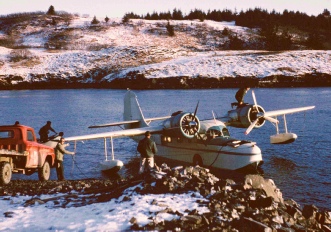
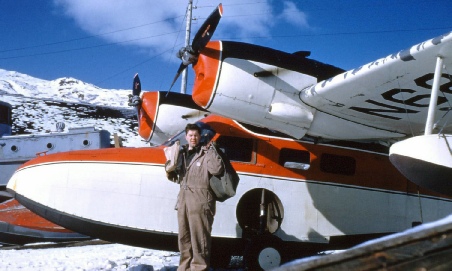
Above: Bob Hall (with sacks of mail) and the same Widgeon as the photo from Kitoi
Bay, here repainted in a pretty multicolor scheme that was not used on any other
plane. For years the yellow and red color scheme predominated, but by the mid-
The photo on the left is a “still frame” from 16mm movie footage shot by my Dad, Rev. Norman Smith. One Widgeon awaits the next flight.

This beautiful Super Widgeon served Munsey’s Bear Camp, and belonged to Park Munsey, a “Master Guide.” Photo taken at the Kodiak Municipal Airport in the late 1970’s. (Dirk Sundbaum photo)
Left: Alaska aviation legend Bob Hall and a Lake “Skimmer” in the early 1960’s (from Steve Harvey’s collection). Right: A Skimmer loads up at Moser Bay (Justin Strom photo).
The Skimmer had a relatively short work span with Kodiak Airways, from the late 1950’s to the roughly the Tidal Wave of 1964. As cute and memorable as it may have been, plain old Cessna 180’s on floats has larger carrying capacity and were much more plentiful. That’s a huge consideration when repairs are needed and you’re looking for spare parts!
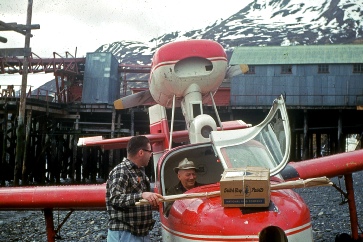
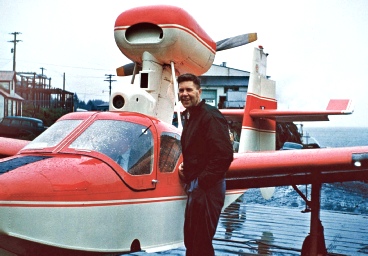
Another Interesting Amphibian: the Lake “Skimmer”
Right: N1583V looking brilliant in its brand new Kodiak Airways colors a few months later, as it roars up onto the beach in the Kodiak channel. The old Kodiak Airways base of operations was close to the KEA generator building and below the Griffin Memorial Hospital, down a narrow cliffside road.
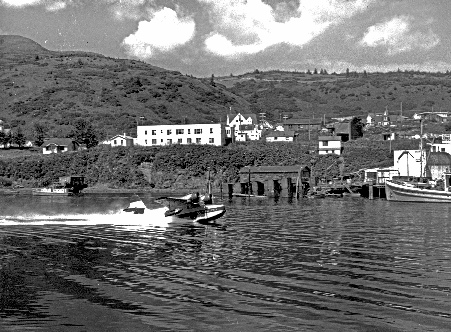

Left: a late 50’s photo, taken by my brother Noel from Near Island, which was at that time not occupied. The photo reveals a Kodiak Airways Goose, in the same paint scheme as the photo above, about to take to the air. The inset enlargement below reveals “Fly Kodiak Airways” painted on the nose / bow.
In Memoriam: Pilots and Planes
Genuine tragedy is also part of the story of amphibious aviation around Kodiak Island. In “From Shore to Sky”, there are photos of a Widgeon that flipped on landing in the Kodiak channel, thankfully with no lives lost. But another landed with its wheels down, a deadly error, and flipped over with loss of life. Because of this uniquely amphibian potential for disaster, I never flew with any pilot who didn’t check, double check and recheck the little indicator light between the pilot and copilot seats that indicated the status of the landing gear. When in doubt, give the hand crank another turn!
Steve Harvey’s dad Bill, who ran Harvey’s Flying Service, died at the Kodiak airstrip in 1967 when his Beechcraft crashed on takeoff. (Although they may have been business competitors, the loss of Bill Harvey was like the death of a family member for all the local pilots, and I remember the loss hit people in the villages pretty hard as well.)
Then in quick succession in 1974 and 1975, Bob Hall’s son Robbie, one of my schoolmates and an old friend, died in a Goose crash at the South End, and Warren Zehe, another friend and son of the indispensable Kodiak Airways dispatcher Archie Zehe, also died in a plane crash. Later another Goose’s pilot became disoriented in the fog near Ouzinkie, even though he was carefully flying close to land and within sight of the water, clipped his pontoon and spiraled in at high speed, and none survived. This too is the legacy of the amphibian pilots in Kodiak Island airspace: danger counterbalanced by skill and determination.
The End of the Line: The Story of the “Peter Rabbit” Goose
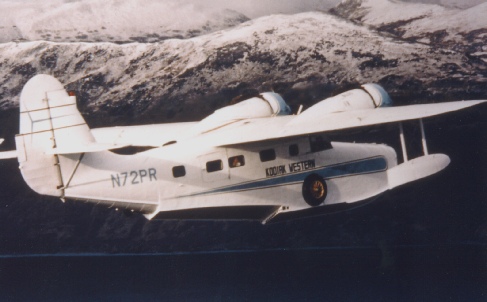
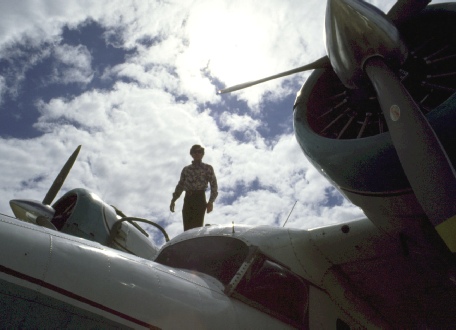
Above Right: Steve Westerfield took this dramatic photo of Fred Ball atop a Goose around the time the above photo was taken. Fred’s photos are key components of the article, “Still Flying” in this series on Kodiak aviation. By the way, the cosmic superhero pose (inadvertent, I’m positive) is how I imagined those pilots when I was a kid. See my fascination with the “Easter Egg” in the article above.
Epilogue: Still Flying!
Every time I return to Alaska, I am pleased to see that the Grumman Goose and Widgeon
are still flying somewhere. But in May of 2004 I had the pleasure of spending the
weekend on Catalina Island, twenty-
More recently, Debbie and I moved to Coeur D’Alene, Idaho when we retired in 2018, and our new home is six miles north of Coeur D’Alene Lake, with a lot of DeHavilland Beavers flying in and out in the summer months. But I heard a persistent rumor that there’s a Grumman Widgeon that lives at Hayden Lake, and we live six miles south of there. So I must find out! If I ever make a connection, I’ll update this article.
Although I have lots of photos and fond memories of the planes, my brother Kelly
actually worked around them during the waning years of Kodiak Western, including
dispatching and flying down somewhere remote to help a pilot with freight. But on
Catalina I spotted a fully-
In the meantime, active pilots still lovingly keep the old birds aloft. The Goose debuted in 1938, and the Widgeon appeared a couple of years later, so parts are hard to come by, but those old planes just keep on flying. One of the pilots who carry the Grumman torch, so to speak, is Steve Harvey, son of Bill Harvey of the old Harvey Flying Service, who continues his father’s bush pilot legacy with his beautiful white, yellow and blue Widgeon. Another is Fred Ball, who flew Grumman Goose for PenAir when it was operating out of Kodiak in the late 1990’s. The story of the Goose and Widgeon around Kodiak Island today is the subject of another section of this series, titled “Goose and Widgeon: Still Flying!”
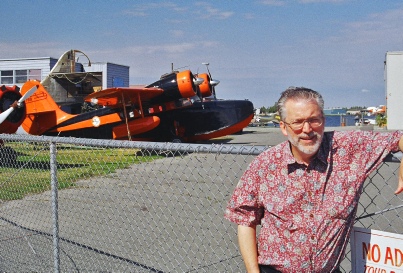
Above: Sure enough, it’s a Goose! Near the Anchorage airport, by the seaplane base, I ran into a very nice Grumman Goose. The talk was that it’s the one used by the Alaska Department of Fish and Game (a logical choice of machinery for that job!) All I know is, I was on the wrong side of the fence here, in my opinion!

One Last Grumman: The Life-
The Grumman amphibians from the World War II era came in four sizes (small to large):
The Widgeon, the Goose, the Mallard, and the Albatross. I’ve never seen a Mallard
except on the cover of a Jimmy Buffett album. Goose and Widgeon we knew like old
friends. But if you saw an Albatross up close, at least until the mid-
A Coast Guard Albatross, with “Kodiak” emblazoned on its tail, floats peacefully
on the ocean in this photo provided by Bill Brophy. A savior of the skies, the Albatross
served Kodiak faithfully from the war years to the mid-
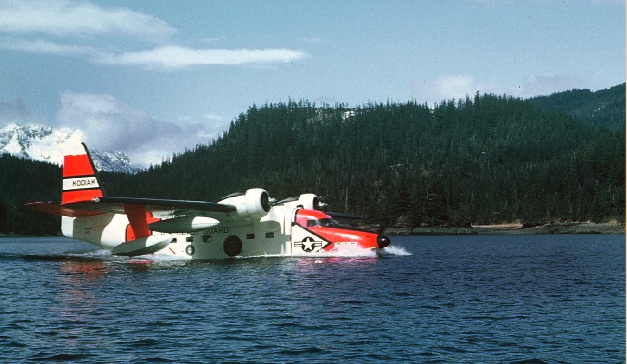
Right: Bob Leonard and a Piper Cub, date and location unknown. Bob sent me this computer-